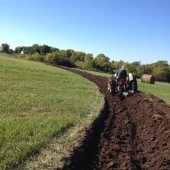posted 8 years ago
I am a bulldozer guy so I prefer bulldozers for making swales, but you have more than enough equipment to build some nice swales. Myself, I like a swale 12-16 inches deep over 8 feet. Why that? Because my bulldozer blade tilts 8 inches over 8 feet and with two passes casting the dirt to the low side of the swale, I get that slope.
If you want a swale in similar shape and dimension, a single bottom/ three bottom plow combination would work good. I actually prefer a single bottom plow because they really go deep, do not ride over the soil as much since there is only one plow point cutting, and they really roll some large rocks out of the way because they are not pushing a rock against another plow share. Obviously follow the contour you want your swale to traverse. If you want a straight line, I lift the bucket of the tractor up to eye level sitting on the seat, sight to a tree across the field (mine has a hook welded in the center of the bucket), then try to line the center of my bucket up with that tree as I travel, and thus get a straight line. If yours is a curved swale, then whatever gets you that path is fine. Then just turn around and plow the opposite way, preferably with the 3 bottom plow. If you can, try and set the plow up so that the first plow share goes deep, then feathers out so the second and third one is not so deep. It is easy to do that if it has a hydraulically controlled tail wheel, but being a 3 bottom, probably has to be adjusted by the 3 point hitch. Or you can just make 3 passes with the single bottom plow making a deep one at first, then a second not as deep pass, then an even lighter 3rd pass.
This will create the start of the swale; one single bottom pass on the lower side, and 3 passes on the upper side. To refine it you can use the grader blade. It is going to take a lot of passes to break up the sod and separate the dirt from the sod clods, but by angling the blade, you should be able to drive in the gully you made, and get the soil loosened on the uphill side to feather out from deep in the gully, to almost nothing. This should be a really good upslope shape...but as I say, might take a few passes.
To shape the downhill side, try to adjust your grader blade so that it shifts as far to the uphill side as you can. DO NOT DRIVE IN THE GULLY. Try staying on top and getting that overturned sod to roll off the grader blade down hill. Again it will take some passes to break up the sod and separate out the dirt, but by this point you should have a decent shaped swale.
You can leave it like this, but I prefer a curved shaped gully to my swales and not a harsh vee shape. You get the final shape by shifting your grader blade as far to the downhill side as you can, then by driving in the gully, but going super slow, and taking a very light cut, you can get the bottom of the swale to really feather out. This is delicate work. Even with a bulldozer it is easy to really mess this part up and cause a lot of extra work, but by going slow, having a light and constant hand on the 3 point hitch lever, you can really make a nice looking swale with hardly any hand tool work. In fact I hate shoveling and raking so much, I don't even use them.
I am not sure if I explained things well, and should I have a better camera to do video, would make a swale with the equipment you have (I have those implements as well) just to show it can easily be done. This post makes it sound far more complicated then it is. The only touchy part is the final shape to get the gully from vee shaped to curved shaped. BUT done right, it is a nice looking finishing touch in my opinion.

 2
2




 2
2




 1
1




 1
1





 1
1




 1
1




 1
1




 2
2




 3
3









